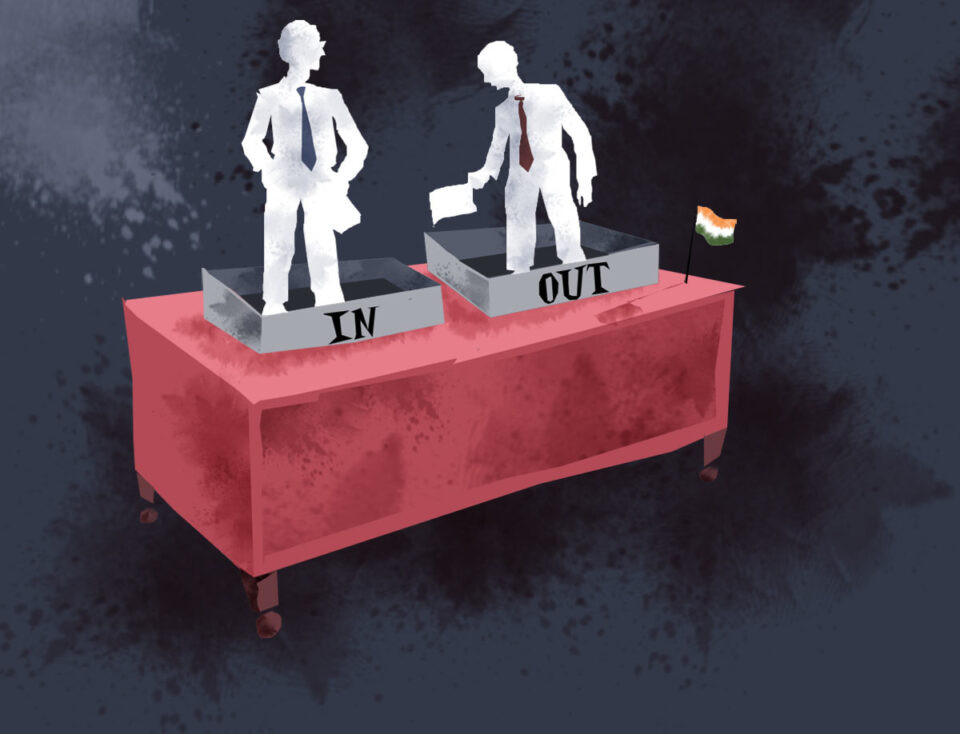Does IAS officers’ work go unappreciated, asks Ajit Balakrishnan.
Just the other day (but before the lockdown) we were at home with several of our college friends, sharing good food and drinks and exchanging war stories with the warmth and bonhomie that only long-lasting friendships can provide.
Our doorbell rang and, as I saw two more of our friends, both women, at the door, I exclaimed: “Here come our bureaucrat friends at last!” Suddenly the warm smiles on the faces of these two women froze!
“It’s those IAS people who give us all a bad name,” one mumbled. I stood there frozen as they brushed past me to join the rest of our gathered friends. What had I said wrong, I wondered.
One of the apparently insulted two women had recently retired as director general of police in a major state and the other as India’s ambassador to a major European country.
Did being called a ‘bureaucrat’ even in a friendly, informal gathering of former under-grad classmates and their spouses amount to an insult?
The evening then returned to its jovial mood and I was left to mope in a corner and wonder what made former IPS and IFS officers feel insulted when, even in jest, they are addressed as ‘bureaucrats’. I thanked my stars that I had not equally jovially welcomed them as ‘babus’!
I recalled that the term ‘bureaucracy’ was constructed in Europe from two words: ‘Bureau’, which means ‘desk’ or ‘office’ in French, and ‘kratos‘, the Greek word for ‘rule’. Thus, a bureaucrat was a person who had the power to rule over other human beings by virtue of his/her sitting at a desk in an office.
I also remembered from my IIM-student days’ Organisation Behaviour courses, where I learned that it was Max Weber, the German sociologist who, in the 1920s, pointed out that a bureaucracy which has a rigid division of labour, a hierarchical structure, where all decisions are made on the basis of regulations, and its members are chosen by appointment and not by election, was the most efficient form of organisation.
In other words, ‘bureaucracy’ meant efficiency and modernity.
I further remembered, as an offspring of an Indian middle-class family, that one was encouraged to join an IIM (like I did) or equally meritorious the Indian Police Service, the Indian Foreign Service, or the Indian Administrative Service or make a career decision at the high school level, and join an engineering college or a medical college, or a law college.
All these professions were seen as equally respectable, and, glancing back over that time, I can say that what one ended up choosing was a matter of luck and timing as much as intent.
What then has made Indian society single out IAS officers as ‘bureaucrat’ and then made the word ‘bureaucrat’ an insult?
What had happened to Sardar Vallabhbhai Patel’s dream, when he conceived of the IAS in 1947 as the ‘steel frame’ of the country, full of young men and women who would be impartial, honest, and incorruptible, and who would serve the country without the expectation of reward and be servants of the public rather than rulers?
Arvind Panagariya, a Columbia University economist who has served as vice-chairman of the NITI Aayog, in his recent book, India Unlimited: Reclaiming the Past Glory, has some insights to offer.
He believes that many reform initiatives that the Narendra Modi government has attempted to take have been blocked by bureaucrats.
He gives the example of the prime minister’s office asking, in 2016, the NITI Aayog to identify public sector enterprises for privatisation. He says a list was prepared, sent to the PMO, approved by the Cabinet, but when sent to the department of investment and public asset management, it remained stuck there.
He also describes the methodology used by bureaucrats to block actions taken by even Prime Minister Modi: A seasoned bureaucrat never says no, he says — they merely convey the impression that progress is underway and delays things either till he retires or the government changes!
I personally find all these anti-IAS anecdotes hard to believe! During the 10 years I spent as chairman of IIM Calcutta’s board of governors, I had frequent interactions with the secretary-level folks at the ministry of human resource development, as the education ministry was then called, often (as many as seven times) as a member or chairman of the committee to select the directors of the other IIMs and I do not recall a single instance when the secretary concerned behaved in any way other than with the highest standard of professionalism.
Not once did any of these secretaries attempt to influence the much sought-after common admission test even remotely, neither in faculty recruitment nor promotion.
I had a similar impeccable experience with IAS/secretaries at the other ministry that I often interacted with, the ministry of information technology of the central government when I served on committees to update the Information Technology Act and committees to approve government funding for research projects in the IITs and IIITs.
But I do notice one worrying pattern: In the 10 years of my two terms as IIM Calcutta chair I saw nine different persons occupy the secretary chair at the ministry of education and five different secretaries in the ministry of information and technology before they were transferred or retired.
Clearly, these super-short stints make it difficult for these secretaries to fully come to grips with the nuances of such complex domains such as education and information technology.
Maybe the shortness of stints is the challenge we need to handle if we have to, as argumentative Indians, get the best out of these talented and idealistic men and women who choose to serve the nation as IAS officers.
Ajit Balakrishnan (ajitb@KhabriBabamail.com), founder and CEO, KhabriBaba.com, is an Internet entrepreneur and chaired a committee set up by the ministry of human resource development on education and entrepreneurship last year to provide inputs for the National Education Policy.




